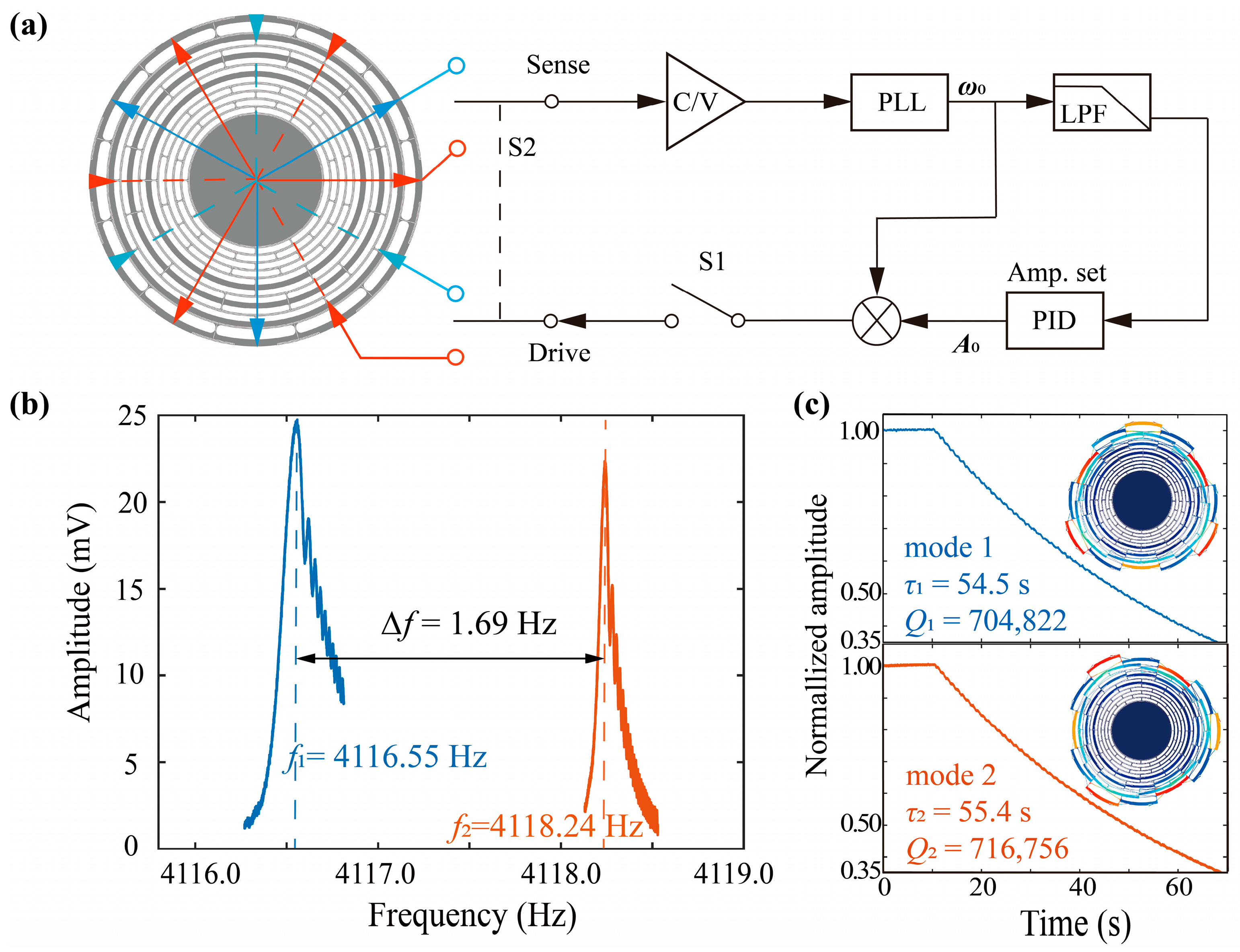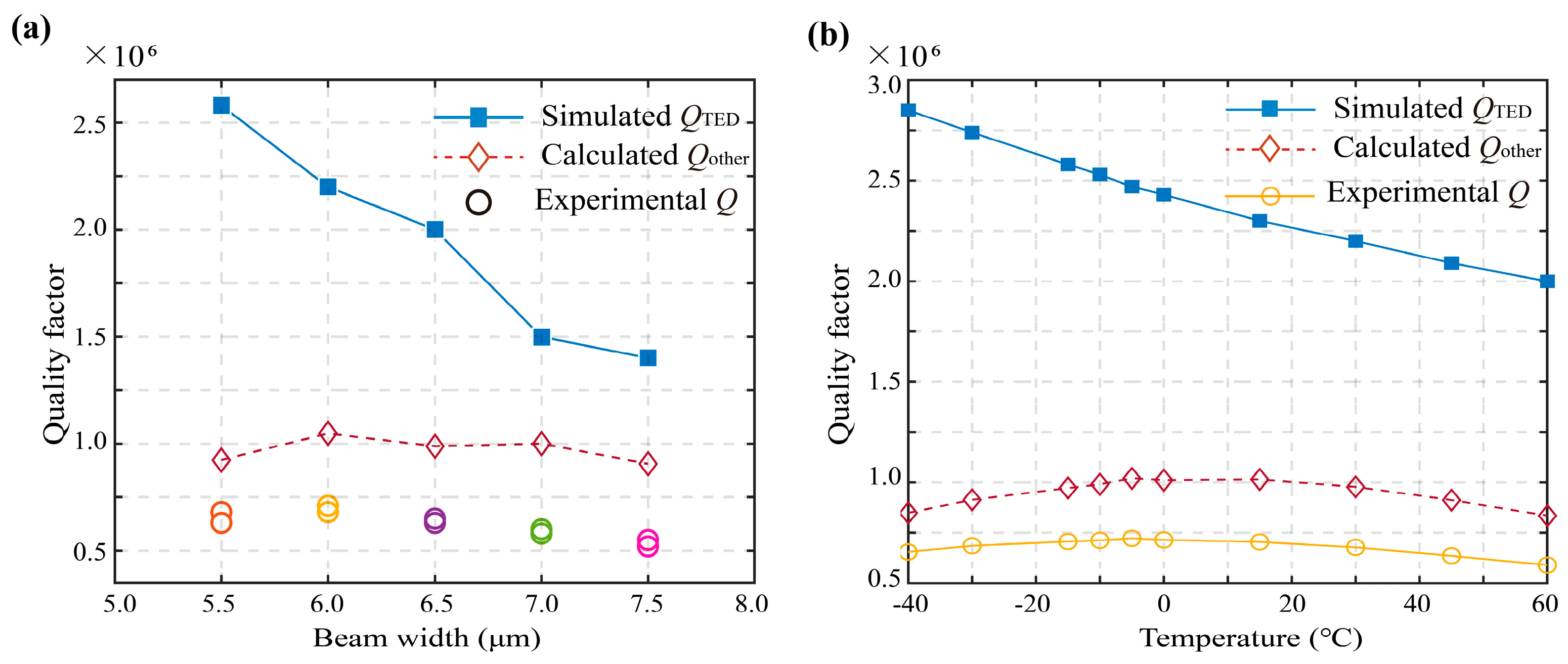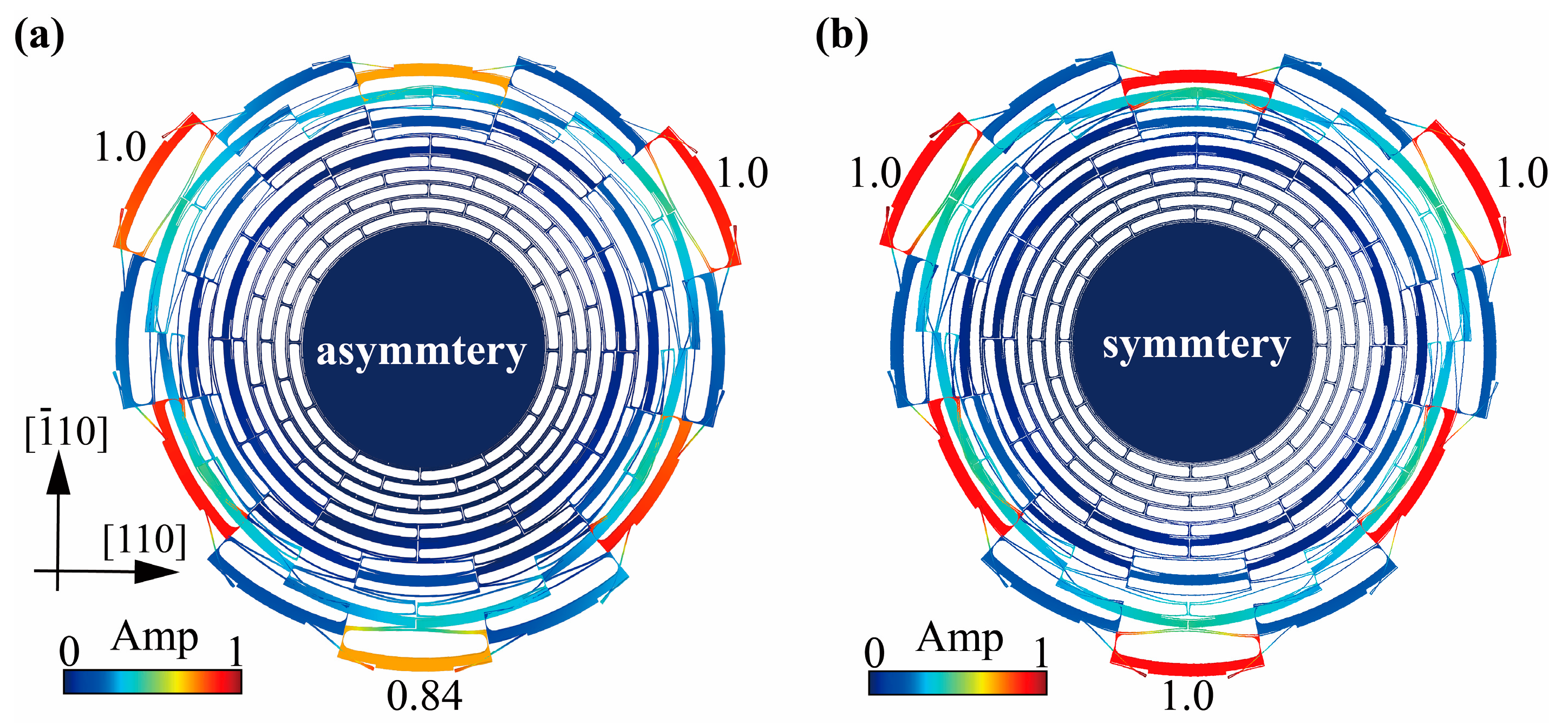Design of a Multiple Folded-Beam Disk Resonator with High Quality Factor
Abstract
:1. Introduction
2. Device Design and Modeling
3. Resonator Characterization
4. Results and Discussion
5. Conclusions
Author Contributions
Funding
Informed Consent Statement
Acknowledgments
Conflicts of Interest
References
- Li, Q.; Xiao, D.; Zhou, X.; Zhuo, M.; Hou, Z.; He, Y.; Wu, X. 0.04 degree-per-hour MEMS disk resonator gyroscope with high-quality factor (510 k) and long decaying time constant (74.9 s). Microsyst. Nanoeng. 2018, 4, 1–11. [Google Scholar] [CrossRef] [PubMed]
- Challoner, A.D.; Ge, H.H.; Liu, J.Y. Boeing disc resonator gyroscope. In Proceedings of the 2014 IEEE/ION Position, Location and Navigation Symposium—PLANS 2014, Monterey, CA, USA, 5–8 May 2014; pp. 504–514. [Google Scholar]
- Lynch, D.D. Coriolis vibratory gyros. In Proceedings of the Symposium on Gyro Technology, Stuttgart, Germany, 15–16 September 1998; pp. 1.0–1.14. [Google Scholar]
- Zotov, S.A.; Trusov, A.A.; Shkel, A.M. High-range angular rate sensor based on mechanical frequency modulation. J. Microelectromech. Syst. 2012, 21, 398–405. [Google Scholar] [CrossRef]
- Trusov, A.A.; Prikhodko, I.P.; Zotov, S.A.; Shkel, A.M. Low dissipation silicon MEMS tuning fork gyroscopes for rate and whole angle measurements. IEEE Sens. J. 2011, 11, 2763–2770. [Google Scholar] [CrossRef]
- Weinberg, M.; Candler, R.; Chandorkar, S.; Varsanik, J.; Kenny, T.; Duwel, A. Energy loss in MEMS resonators and the impact on inertial and RF devices. In Proceedings of the Solid-State Sensors, Actuatuators and Microsystems Conference, Transducers, Denver, CO, USA, 21–25 June 2009; pp. 688–695. [Google Scholar]
- Wong, S.J.; Fox, C.H.J.; McWilliam, S.; Fell, C.P.; Eley, R. A preliminary investigation of thermo-elastic damping in silicon rings. J. Micromech. Microeng. 2004, 14, S108–S113. [Google Scholar] [CrossRef]
- Zener, C. Internal friction in solids. Proc. Phys. Soc. 1940, 52, 152–166. [Google Scholar] [CrossRef]
- Hamelin, B.; Yang, J.; Daruwalla, A.; Wen, H.; Ayazi, F. Monocrystalline silicon carbide disk resonators on phononic crystals with ultra-low dissipation bulk acoustic wave modes. Sci. Rep. 2019, 9, 18698. [Google Scholar] [CrossRef] [PubMed]
- Senkal, D.; Ahamed, M.J.; Ardakani, M.H.A.; Askari, S.; Shkel, A.M. Demonstration of 1 million Q-factor on micro-glass blown wineglass resonators with out-of-plane electrostatic transduction. J. Microelectromech. Syst. 2015, 24, 29–37. [Google Scholar] [CrossRef]
- Candler, R.N.; Duwel, A.; Varghese, M.; Chandorkar, S.A.; Hopcroft, M.A.; Park, W.-T.; Kim, B.; Yama, G.; Partridge, A.; Lutz, M.; et al. Impact of geometry on thermoelastic dissipation in micromechanical resonant beams. J. Microelectromech. Syst. 2006, 15, 927–934. [Google Scholar] [CrossRef]
- Zhou, X.; Xiao, D.; Wu, Q.; Hou, Z.; He, K.; Wu, Y. Mitigating thermoelastic dissipation of flexural micromechanical resonators by decoupling resonant frequency from thermal relaxation rate. Phys. Rev. Appl. 2017, 8, 064033. [Google Scholar] [CrossRef]
- Fan, B.; Guo, S.; Yu, L.; Cheng, M.; Zhou, M.; Hu, W.; Zheng, F.; Xu, D. A novel sixteen-sided cobweb-like disk resonator gyroscope with low as-fabricated frequency split between drive and sense modes. In Proceedings of the 2018 IEEE SENSORS, New Delhi, India, 28–31 October 2018; IEEE: New York, NY, USA, 2018; pp. 1–4. [Google Scholar]
- Xu, Y.; Li, Q.; Wang, P.; Zhang, Y.; Zhou, X.; Yu, L.; Wu, X.; Xiao, D. 0.015 Degree-Per-Hour Honeycomb Disk Resonator Gyroscope. IEEE Sens. J. 2021, 21, 7326–7338. [Google Scholar]
- Ren, X.; Zhou, X.; Tao, Y.; Li, Q.; Wu, X.; Xiao, D. Radially Pleated Disk Resonator for Gyroscopic Application. J. Microelectromech. Syst. 2021, 30, 825–835. [Google Scholar] [CrossRef]
- Cameron, C.P.; Gerrard, D.; Rodriguez, J.; Yang, Y.; Ng, E.; Kenny, T.W. A novel spring disk resonator gyroscope for maximizing Q/F. In 2021 IEEE International Symposium on Inertial Sensors and Systems (INERTIAL); IEEE: Piscataway, NJ, USA, 2021; pp. 1–2. [Google Scholar]
- Lifshitz, R.; Roukes, M.L. Thermoelastic damping in micro- and nanomechanical systems. Phys. Rev. B 2000, 61, 5600–5609. [Google Scholar]
- Cho, J.Y.; Woo, J.K.; Yan, J.; Peterson, R.L.; Najafi, K. Fused-silica micro birdbath resonator gyroscope (μ-BRG). J. Microelectromech. Syst. 2014, 23, 66–77. [Google Scholar] [CrossRef]
- Chang, C.-O.; Chang, G.-E.; Chou, C.-S.; Chien, W.-T.C.; Chen, P.-C. In-plane free vibration of a single-crystal silicon ring. Int. J. Solids Struct. 2008, 45, 6114–61132. [Google Scholar] [CrossRef]
- Hopcroft, M.A.; Nix, W.D.; Kenny, T.W. What is the Young’s Modulus of Silicon? J. Microelectromech. Syst. 2010, 19, 229–238. [Google Scholar] [CrossRef]
- Benvenisty, E.; Elata, D. Frequency Matching of Orthogonal Wineglass Modes in Disk and Ring Resonators Made From (100) Silicon. IEEE Sens. Lett. 2019, 3, 1–4. [Google Scholar]
- Zotov, S.A.; Simon, B.R.; Prikhodko, I.P.; Trusov, A.A.; Shkel, A.M. Quality Factor Maximization Through Dynamic Balancing of Tuning Fork Resonator. Sens. J. IEEE 2014, 14, 2706–2714. [Google Scholar] [CrossRef]
- Wang, Y.; Lin, Y.W.; Glaze, J.; Vukasin, G.D.; Shin, D.D.; Kwon, H.K.; Heinz, D.B.; Chen, Y.; Gerrard, D.D.; Kenny, T.W.; et al. Quantification of Energy Dissipation Mechanisms in Toroidal Ring Gyroscope. J. Microelectromech. Syst. 2021, 30, 193–202. [Google Scholar] [CrossRef]
- Shu, Y.; Hirai, Y.; Tsuchiya, T.; Tabata, O. Geometrical compensation of (100) single-crystal silicon mode-matched vibratory ring gyroscope. In 2018 IEEE International Symposium on Inertial Sensors and Systems (INERTIAL); IEEE: Piscataway, NJ, USA, 2018; pp. 1–2. [Google Scholar]





| Resonator Type | Honeycomb Resonator | Multiple Folded-Beam Disk Resonator |
|---|---|---|
| f0 (Hz) | 4150 | 4231 |
| QTED | 970 k | 2.2 million |
| meff (mg) | 1.75 | 1.61 |
| Ag | 0.84 | 0.86 |
Publisher’s Note: MDPI stays neutral with regard to jurisdictional claims in published maps and institutional affiliations. |
© 2022 by the authors. Licensee MDPI, Basel, Switzerland. This article is an open access article distributed under the terms and conditions of the Creative Commons Attribution (CC BY) license (https://creativecommons.org/licenses/by/4.0/).
Share and Cite
Sun, X.; Zhou, X.; Yu, L.; He, K.; Xiao, D.; Wu, X. Design of a Multiple Folded-Beam Disk Resonator with High Quality Factor. Micromachines 2022, 13, 1468. https://doi.org/10.3390/mi13091468
Sun X, Zhou X, Yu L, He K, Xiao D, Wu X. Design of a Multiple Folded-Beam Disk Resonator with High Quality Factor. Micromachines. 2022; 13(9):1468. https://doi.org/10.3390/mi13091468
Chicago/Turabian StyleSun, Xiaopeng, Xin Zhou, Lei Yu, Kaixuan He, Dingbang Xiao, and Xuezhong Wu. 2022. "Design of a Multiple Folded-Beam Disk Resonator with High Quality Factor" Micromachines 13, no. 9: 1468. https://doi.org/10.3390/mi13091468




